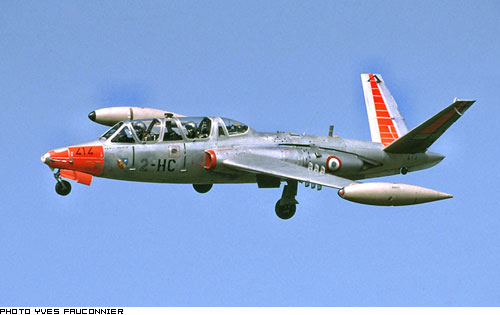CM 170 Magister
Summary
| Category | Military Training Aircraft |
| Origin country | 🇫🇷 France |
| Manufacturer | Fouga |
| First flight | 23 July 1952 |
| Year introduced | 1956 |
| Number produced | 929 units |
| Average unit price | $0.8 million |
Description
In 1948, designers Pierre Mauboussin, Robert Castello, and Jacques Henrat at Fouga commenced work on a jet-propelled primary trainer, designated the CM.130, for the French Air Force as a replacement for piston-engined Morane-Saulnier MS.475s. After the AdA determined that the aircraft lacked sufficient power using two Turbomeca Palas turbojet engines, Fouga enlarged the design, equipping it with the more powerful Turbomeca Marboré engine while retaining the distinctive butterfly tail from the Fouga CM.8 glider, modified with a keel under the rear fuselage to mitigate negative dihedral effects during rudder use. In December 1950, the AdA ordered three prototypes, and the first aircraft flew on 23 July 1952. A pre-production batch of 10 aircraft was ordered in June 1953, followed by an initial production order for 95 aircraft on 13 January 1954. By October 1955, all 13 pre-production Magisters were complete, and the first flight of the first production aircraft was imminent. Production of Magister parts was split between Morane-Saulnier (Ossun), Fouga (Aire-sur-l'Adour), and Latécoère (Toulouse), with final assembly by Fouga in a new plant at Toulouse-Blagnac. Any export orders were typically prioritized over French government orders, enabling overseas countries to procure aircraft "off the line" with minimal delays. The Aéronavale adopted a carrier-capable derivative, the CM.175 Zéphyr, preceded by two "proof of concept" prototypes, designated the CM.170M Magister, which first flew in 1956 and 1957 respectively. By 1960, over 350 Magisters were in service, with French production reaching five aircraft per month, projecting a total of over 600 French-built units. The type was also produced overseas under license in West Germany, Finland, and Israel, with a combined total of 286 aircraft completed. Production of the improved CM.170-2 Magister, powered by a more powerful Turbomeca Marboré IV engine, began in 1960, while French production ended in 1962, though licensed production continued in Finland until 1967, in response to the AdA selecting the Alpha Jet as its new jet trainer.
The Fouga CM.170 Magister was designed for both basic and intermediate training, featuring a compact, tandem seat arrangement. Powered by two Turbomeca Marboré turbojet engines, each providing 880 lb of thrust, the Magister was promoted for its "twin-engine safety with single-engined flying characteristics" due to minimal asymmetric thrust in case of engine failure. The design emphasized operational simplicity, minimizing pre-take-off procedures and ensuring high accessibility for servicing, allowing for engine swaps in approximately 45 minutes. Optional nose-mounted 7.5 mm guns, underwing hard points for rockets or bombs, a nose-tip landing light, and Messier-built nosewheel with retractable taxiing light further enhanced its capabilities.
The Magister could be outfitted with a pair of 7.5 mm or 7.62 mm machine guns in the nose, complete with a 200-round ammunition box for each gun and a mechanism for collecting both links and cases. Underwing hard points allowed for the carriage of up to 140 kg (310 lb) of external stores, including 50 kg (110 lb) bombs, unguided rockets (T 10, T 900 or SNEB rocket pods), and Nord Aviation SS.11 anti-tank missiles.
The Fouga Magister saw operational use in various roles beyond its primary function as a trainer. While operated by display teams such as the Patrouille de France, it was also deployed in combat situations. During the Six-Day War, the Israeli Air Force utilized Magisters for close air support, reportedly destroying numerous tanks and armored vehicles, albeit with heavy losses. El Salvador employed Magisters as ground attack aircraft during its civil war, cooperating with other aircraft types in bombing missions and strafing with nose-mounted machine guns. The pro-secessionist Katangese Air Force used the Magister against United Nations peacekeepers during the Congo Crisis, destroying aircraft on the ground and attacking ground targets. Similarly, the Moroccan Air Force employed Magisters in the Western Sahara War, though losses eventually led to their replacement in combat roles. The Finnish Air Force assigned a secondary attack role to their Magisters in case of war, given limitations imposed by peace agreements.
Main Variants:
-
CM.170-1 Magister: The first production version, equipped with Turbomeca Marboré II engines, with 761 units built across France, West Germany, Finland, and Israel.
-
CM.170-2 Magister: An upgraded model featuring more powerful Marboré VI engines, delivering increased thrust, with a total of 137 aircraft produced.
-
CM.175 Zéphyr: A specialized shipboard trainer variant designed for the French Aéronavale, incorporating a strengthened undercarriage, catapult attachments, and an arrestor hook for carrier operations; 30 were built.
-
IAI Tzukit: An Israeli Air Force version, also known as AMIT Fouga, updated with a new cockpit and composite materials to extend its operational life.
-
Fouga 90/90A: A development based on the CM.170, integrating Turbomeca Astafan engines, a reshaped canopy for enhanced visibility, and upgraded avionics, though it ultimately failed to attract orders.
Technical specifications
| Version: CM.175 Zéphyr | |
|---|---|
| Crew | 2 pilots |
| Operational range | 1,200 km (746 mi) |
| Maximum speed | 639 km/h (397 mph) |
| Wing area | 17.3 m² (186.2 sqft) |
| Wingspan | 11.3 m (37.2 ft) |
| Height | 2.9 m (9.5 ft) |
| Length | 10.2 m (33.5 ft) |
| Service ceiling | 9,144 m (30,000 ft) |
| Empty weight | 2,540 kg (5,600 lbs) |
| Max. takeoff weight | 3,450 kg (7,606 lbs) |
| Takeoff distance | 720 m (2,362 ft) |
| Powerplant | 2 x turbojets Turbomeca Marboré II G3 delivering 440 kgf each |
Current operating countries
All operators
Armament
Bombs payload:
- Training SAMETO

